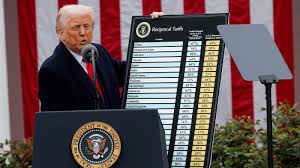Editor’s Note: This article was accurate as of the time of publication. This is ongoing and constantly changing issue.
Tariffs were one of President Trump’s primary selling points throughout his campaign for the 2024 election. Through the power of the tariff, he promised that America would return to being the strongest nation in the world. He promised everyone would be rich and the national debt would go down. But can tariffs really do as much for the US economy as President Trump says they can?
What are tariffs and who pays them?
A tariff is a tax or duty paid on a particular class of imports or exports from other countries. They are a kind of revenue that governments use all around the world. However, This is not a tax that’s placed on the foreign country selling the merchandise but a tax on the domestic company that is buying said merchandise. Tariffs are meant to implore domestic companies to buy domestic parts and manufacture their products within the country. For example, tariffs would motivate car companies to buy domestic car parts and manufacture their cars inside of their country.
Who did he tariff and why?
On February 1, President Trump followed through with the promise of tariffs. He placed a 25% tariff on our two neighboring countries and long-time allies, Mexico and Canada. His reasoning for this was due to “The extraordinary threat posed by illegal aliens and drugs, including deadly fentanyl.” He also placed a 10% tariff on China due to them being America’s top competing nation that is not an ally. But two days later, Trump paused the tariffs after reaching agreements with each country that included commitments to increase border enforcement.
What Happened at the End of the one-month Pause on Tariffs?
On February 27, Trump informed the public that he plans to go through with resuming the tariffs on March 4, when the one-month pause ends. As Trump was reiterating these plans on March 3 on a live broadcast from the White House, the stock market fell. The S&P 500 closed down 1.7%, its worst trading day since December. On March 4, the tariffs hit, beginning the trade war, and Canada and Mexico prepared their counter-measures.
What is a Trade war?
Rather than a normal war where countries try to defeat the other country through force, trade wars are fought using economics. The goal of either country is to economically cripple the other using tariffs, taxes, and other trade barrier laws preventing trade from occurring within the other country. The goal of a trade war is to force the targeted country to make concessions to alleviate the economic pressure by changing its policies.
How did other countries respond to the Tariffs?
Canada Responded immediately after the tariffs went live. Justin Tradeua, Canada’s Prime Minister, went on live TV and announced the retaliatory tariffs that they would be placing on the USA. Canada will impose 25% tariffs on C$30 billion($20.80 billion) in goods imported from the U.S. effective immediately.
Mexico however, did not release retaliatory tariffs on America. Instead, President Sheinbaum held a Rally in Mexico City’s Zocalo Square for an event aimed at increasing national pride, and highlighted the economic contributions that Mexico and its people make to the U.S. economy. Sheinbaum announced that there would be countermeasures taken against the US that would be announced soon.
China has responded with tariffs of 15% on some US agriculture imports, including chicken, corn, cotton and wheat, which are set to come in from 10 March. They also added a 10% levy on US aquatic products, beef, dairy, fruits and vegetables, pork, soybeans, and sorghum imports. Trump stated that his reasoning for terrifying China was due to their inability to stop Fetnyl from entering the US on Chinese ships. The Chinese government responded with “the root cause of the fentanyl issue lies in the US itself”, and accused the US of “blackmailing China by imposing tariffs”.
What products will this affect?
The USA manufactures a large portion of their own products but there are still a large amount of products that will be affected. Potatoes, grains, lumber and steel will increase in price because we acquire them from Canada. Prices will increase on cars, fruits, vegetables, alcohol, electronics, chicken, wheat, corn, cotton, sorghum, soybeans, pork, beef, seafood, and dairy products.
What are the economists saying about the tariffs?
While Trump says that tariffs create many US jobs, economists say otherwise. According to Mark Zandi, the chief economist of Moody’s. “It costs American jobs,” He also categorizes tariffs as a “lose-lose” and explains: “There are no winners here in the trade war we’re seemingly being engulfed in.”
According to Lydia Cox, an assistant economics professor at the University of Wisconsin-Madison and international trade expert, “Tariffs create higher input costs for other industries, making them ‘vulnerable’ to foreign competition. These spillover effects hurt other sectors of the economy, ultimately costing jobs.”
The steel industry will be greatly affected, for example. Shannon O’Neil and Julia Huesa, researchers at the Council on Foreign Relations explained how “Steel tariffs raise production costs for the manufacturing sector and other steel-intensive U.S. industries, like automobiles, farming machinery, household appliances, construction and oil drilling.” In 2003, then-President George W. Bush implemented a steel tariff. After Cox conducted some research into the tariff, she found that they were responsible for 168,000 fewer jobs per year in steel-using industries, on average — more jobs than there are in the entire steel sector. The overall consensus of economists is against tariffs due to their lack of job growth and increased costs for the consumer.
